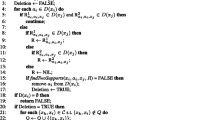Abstract
Arc-consistency algorithms are the workhorse of backtrackers that maintain arc-consistency (MAC). This paper will provide experimental evidence that, despite common belief to the contrary, it is not always necessary for a good arc-consistency algorithm to have an optimal worst-case time-complexity. Sacrificing this optimality allows MAC solvers that (1) do not need additional data structures during search, (2) have an excellent average time-complexity, and (3) have a space-complexity that improves significantly on that of MAC solvers that have optimal arc-consistency components. Results will be presented from an experimental comparison between MAC-2001, MAC-3 d and related algorithms. MAC-2001 has an arc-consistency component with an optimal worst-case time-complexity, whereas MAC-3 d does not. MAC-2001 requires additional data structures during search, whereas MAC-3 d does not. MAC-3 d has a O(e+nd) of space-complexity, where n is the number of variables, d the maximum domain size, and e the number of constraints. We shall demonstrate that MAC-2001's space-complexity is O(edmin(n,d)). Our experimental results indicate that MAC-2001 was slower than MAC-3 d for easy and hard random problems. For real-world problems things were not as clear.
Similar content being viewed by others
References
Bessière, C., Freuder, E. & Ré gin, J.C. (1995). Using Inference to Reduce Arc Consistency Computation. In C. Mellish (ed.) Proceedings of the Fourteenth International Joint Conference on Artificial Intelligence, Vol. 1, 592–598 Montréal, Québec, Canada: Morgan Kaufmann Publishers.
Bessière, C., Freuder, E. & Régin, J.-C. (1999). Using Constraint Metaknowledge to Reduce Arc Consistency Computation. Artificial Intelligence 107(1): 125–148.
Bessière, C. & Règin, J.-C. (2001). Refining the Basic Constraint Propagation Algorithm. In Proceedings of the Seventeenth International Joint Conference on Artificial Intelligence, 309–315.
Cabon, B., De Givry, S., Lobjois, L., Schiex, T. & Warners, J. (1999). Radio Link Frequency Assignment. Journal of Constraints 4: 79–89.
Gaschnig, J. (1978). Experimental Case Studies of Backtrack vs. Waltz-Type vs. New Algorithms for Satisficing Assignment Problems. In Proceeding of the 2nd Biennial Conference, Canadian Society for the Computational Studies of Intelligence, 268–277.
Gent, I., Prosser, M. E. P., Smith, B. & Walsh, T. (1996). An Empirical Study of Dynamic Variable Ordering Heuristics for the Constraint Satisfaction Problem. In E. Freuder (ed.) Principles and Practice of Constraint Programming, 179–193, Berlin: Springer.
Gent, I., Maclntyre, E., Prosser, P., Shaw, P. & Walsh, T. (1997). The Constrained-ness of Arc Consistency. In Proceedings of the 3rd International Conference on Principles and Practice of Constraint Programming, 327–340, Berlin: Springer.
Gent, I., Maclntyre, E., Prosser, P., Smith, B. & Walsh, T. (2001). Random Constraint Satisfaction: Flaws and Structure. Journal of Constraints 6(4): 345–372.
Mackworth, A. (1977). Consistency in Networks of Relations. Artificial Intelligence 8: 99–118.
Mackworth, A. & Preuder, E. (1985). The Complexity of Some Polynomial Network Consistency Algorithms for Constraint Satisfaction Problems. Artificial Intelligence 25(1): 65–73.
Mohr, R. & Henderson, T. (1986). Arc and Path Consistency Revisited. Artificial Intelligence 28: 225–233.
Sabin, D. & Freuder, E. (1994). Contradicting Conventional Wisdom in Constraint Satisfaction. In A. Cohn (ed.) Proceedings of the 11th European Conference on Artificial Intelligence, 125–129, New York: John Wiley and Sons.
van Dongen, M. (2001). Domain Heuristics for Arc-Consistency Algorithms. In Proceedings of the 12th Irish Conference on Artificial Intelligence and Cognitive Science, 179–188.
van Dongen, M. (2002). AC-3d an Efficient Arc-Consistency Algorithm with a Low Space-Complexity. In P. Van Hentenryck (ed.) Proceedings of the 8th International Conference on Principles and Practice of Constraint Programming, Vol. 2470 of Lecture notes in Computer Science, 755–760, Berlin: Springer.
van Dongen, M. (2003a). Domain-Heuristics for Arc-Consistency Algorithms. In B. O'Sullivan (ed.) Recent Advances in Constraints, Vol. 2627 of Lecture Notes in Artificial Intelligence, 61–75, Berlin: Springer.
van Dongen, M. (2003b). Lightweight Arc-Consistency Algorithms. Technical Report TR-01-2003, Cork Constraint Computation Centre.
van Dongen, M. (2003c). Lightweight MAC Algorithms. Technical Report TR-02-2003, Cork Constraint Computation Centre.
Wallace, R. & Freuder, E. (1992). Ordering Heuristics for Arc Consistency Algorithms. In AI/GI/VI'92, 163-169, Vancouver, British Columbia, Canada.
Zhang, Y. & Yap, R. (2001). Making AC-3 an Optimal Algorithm. In Proceedings of the Seventeenth International Joint Conference on Artificial Intelligence, 316–321.
Rights and permissions
About this article
Cite this article
van Dongen, M. Saving Support-Checks Does Not Always Save Time. Artificial Intelligence Review 21, 317–334 (2004). https://doi.org/10.1023/B:AIRE.0000036261.28708.7f
Issue Date:
DOI: https://doi.org/10.1023/B:AIRE.0000036261.28708.7f




